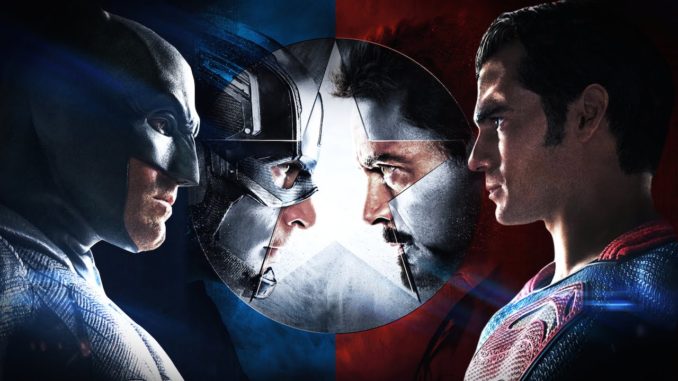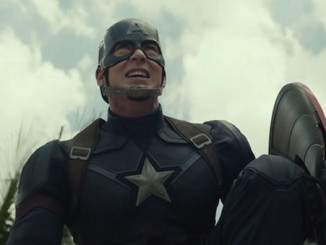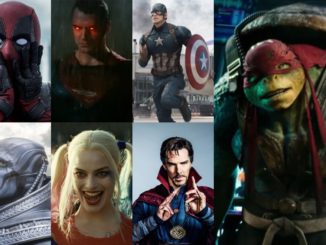 North vs South. Yankees vs. Red Sox. Democrat vs. Republican. These are all petty squabbles compared to the battles between fans of Marvel Comics vs. DC Comics. The proof is the reaction each side will have to Captain America: Civil War vs. Batman V Superman.
North vs South. Yankees vs. Red Sox. Democrat vs. Republican. These are all petty squabbles compared to the battles between fans of Marvel Comics vs. DC Comics. The proof is the reaction each side will have to Captain America: Civil War vs. Batman V Superman.
While many comic book fans aren’t interested in picking a side between the companies, the ones that do support their company with an almost religious fervor. And this passion has followed over to the world of film. While DC got the jump start over Marvel in the comic books, it has been playing catch up to Marvel in the films.
This has made many a DC film fan testy when it comes to the criticism Batman V Superman: Dawn of Justice has received. Critics, including us on the FBOL staff, have been accused of finding flaws in that film because we are just Marvel fanboys, going so far as to suggest that we either are on the Marvel payroll, or drank the Kool-Aid of someone who is.
I’m sure these DC fanboys are rankling at the phenomenal reviews Captain America: Civil War is getting. Whether they have seen the film or not, they think the anti-DC conspiracy is at play once again. But is it? Do they have a point? Is Batman V Superman: Dawn of Justice the better film and Captain America: Civil War just a bad movie with good press?
Luckily, both films are thematically similar with many plot points that mirror one another. We are able to compare the two films on a number of levels to see which film really is the better.
Needless to say, in order to compare the films, we have to delve into spoilers. While if you haven’t seen BvS (as I will be calling Batman V Superman from now on) yet, odds are that you aren’t going to see it. However, CA:CW (what I will be calling Captain America: Civil War from now on) just opened, so if you haven’t seen that you might want to stop reading now. Consider this your final:

The Africa scenes
Both films share a central theme: the damage the heroes cause is a cause of concern for the public and the government, and both films have scenes set in Africa to drive this point home.
In BvS, Lois Lane is kidnapped by an African warlord she was doing an interview with, which naturally will get Superman’s attention. Around the same time, some of the mercenaries working for the warlord start killing the warlord’s other men. It turns out that the mercenaries were really working for Lex Luthor, and were armed with special bullets created by him.
Luthor’s men were there to frame Superman for…something. It is never clearly defined, and most guesses depend on what Lex’s special bullets were meant to do, which isn’t explained in the film. If they were just souped up versions of conventional bullets, then Lex wanted it to look like things go to hell just by Superman showing up. If, as I think yet nobody else on the Internet does, that the bullets were meant to replicate Supes’ heat vision, then Lex wanted it to look like Superman went on a kill crazy rampage, which makes far more sense from a framing perspective.
It would be nice if the point of this scene was clearer, or if it wasn’t completely superfluous. After all, the death count in the last film should have been more than plenty for Supes to be called in front of Congress, and the film is nice enough to open with a look at that from Bruce Wayne’s point of view.
 In CA:CW, the film opens with the Avengers tracking down Crossbones in Lagos, Nigeria. The team stops him from stealing a biological weapon, but when they try to apprehend the villain, he detonates a bomb in an attempt to kill himself and Captain America. The Scarlet Witch is able to contain the explosion, but, in an effort to release the energy from the blast safely, inadvertently redirects the blast into a nearby building, killing a number of people.
In CA:CW, the film opens with the Avengers tracking down Crossbones in Lagos, Nigeria. The team stops him from stealing a biological weapon, but when they try to apprehend the villain, he detonates a bomb in an attempt to kill himself and Captain America. The Scarlet Witch is able to contain the explosion, but, in an effort to release the energy from the blast safely, inadvertently redirects the blast into a nearby building, killing a number of people.
If we are being brutally honest here, this scene is a bit superfluous too. There are plenty of examples in previous films, examples used by General Ross later in the film, that you can say we really didn’t need another one. But, unlike the BvS Africa scene, there was no call back to the former destruction to open the film. So this scene does serve some purpose in the way of an inciting incident.
However, the CA:CW Africa scene is better in one important way. In BvS, they go out of their way to absolve Superman of what had happened in Africa. In CA:CW, the deaths are definitely Scarlet Witch’s fault, albeit accidentally. This ads a fair bit of depth to the conflict and when she is place under what amounts to house arrest, you’ll feel for her and that they made the right decision.
And to add some more pathos in, the Avengers got themselves in that situation to save a whole bunch of lives from that pathogen that Crossbones stole. Superman got into his predicament just to save his main squeeze. That makes CA:CW all the more weightier as the intentions were better.
Setting up the future
 BvS had the heavy workload of taking what Man of Steel started and turn it into the DC Extended Universe. And it did a great job getting fans to fall in love with Wonder Woman. I’m sure that if Warners set up tables outside of every showing of BvS that first week and sold advance tickets for 2017’s Wonder Woman film, they’d make money hand over fist. And Ben Affleck’s time worm. battle weary yet, surprisingly, more athletic Batman is a character I’d like to explore further.
BvS had the heavy workload of taking what Man of Steel started and turn it into the DC Extended Universe. And it did a great job getting fans to fall in love with Wonder Woman. I’m sure that if Warners set up tables outside of every showing of BvS that first week and sold advance tickets for 2017’s Wonder Woman film, they’d make money hand over fist. And Ben Affleck’s time worm. battle weary yet, surprisingly, more athletic Batman is a character I’d like to explore further.
But the rest? The Flash got the most screen time–meaning two scenes–and left me wishing… that Warners just decided to let Grant Gustin do the part. The rest get brief videos as teasers. Aquaman’s left me wanting… to know how long Jason Momoa had to hold his breath for his scene. And Cyborg’s left me wanting… to know what that high tech dry erase board he was embedded in was and how it could possibly be sanitary.
I kid. This would have been fine if it wouldn’t be compared to CA:CW. But, unfortunately, it is.
CA:CW was for all intents and purposes the origin story of Black Panther. T’Challa is introduced, sees his father die, goes on a search for vengeance, and ends with him realizing the shallowness of revenge. That’s a whole film’s worth of a character arc done for a supporting character in another film, all done seamlessly in such a way that it enhances the main plot instead of taking away from it. When Black Panther hits theaters, it can go right into the adventures of the character, because all the heavy lifting has already been done here.
 And then there’s Spider-Man. Widely seen as the breakout star of the film, fans seemed to forget and/or forgive that this was the second reboot of the character in four years. Because we finally got the wise-cracking, hyperactive, scientific genius Spider-Man from the comics. And unlike BvS, which felt the need to rehash Batman’s origin not once but twice, Spidey’s origin is only referenced to in dialogue, with a perfect “teen speak’ interpretation of the “with great power comes great responsibility” line.
And then there’s Spider-Man. Widely seen as the breakout star of the film, fans seemed to forget and/or forgive that this was the second reboot of the character in four years. Because we finally got the wise-cracking, hyperactive, scientific genius Spider-Man from the comics. And unlike BvS, which felt the need to rehash Batman’s origin not once but twice, Spidey’s origin is only referenced to in dialogue, with a perfect “teen speak’ interpretation of the “with great power comes great responsibility” line.
And yes, BvS gave us more of a look into the future of their shared universe than CA:CW did. But cameos by Doctor Strange and Captain Marvel didn’t fit in with the film’s narrative so we didn’t get any. Too bad Warners didn’t have the same thought process. If they took the time to make The Flash, Aquaman and Cyborg more than flickers on a video screen, we might be looking forward their film like we are Black Panther, Spider-Man: Homecoming or Wonder Woman.
The Machiavellian villain behind it all
 The hero on hero conflict had a little bit of help behind the scene by a classic villain on each side, Lex Luthor in BvS and Helmut Zemo in CA:CW. And while both worked behind the scenes to bring death and destruction to our heroes, only one had the screen time devoted to make them a more interesting character.
The hero on hero conflict had a little bit of help behind the scene by a classic villain on each side, Lex Luthor in BvS and Helmut Zemo in CA:CW. And while both worked behind the scenes to bring death and destruction to our heroes, only one had the screen time devoted to make them a more interesting character.
As its stands, the lion’s share of Lex’s characterization comes from the way he was portrayed in other films and in the comics. He starts out as a quirky and odd genius with an attitude towards Superman not far removed Batman’s: he’s dangerous and we need safeguards in case he goes rogue.
But perhaps his motivation was too much like Batman’s, because halfway through the film he turns into a homicidal maniac with no compunction about killing hundreds of people at the U.S. Capitol, kidnapping Lois and Martha with the intent of killing both of them, or releasing the mindless beast that is Doomsday to go on a rampage of destruction that had the potential to kill more people than Supes vs. Zod did. However, there is no reason why Lex went off the deep end other than, well, the performances of Gene Hackman and Kevin Spacey before him.
And it wouldn’t have taken much to make this decent into madness believable. Maybe play up the insanity bubbling beneath the surface in the early scenes. Or perhaps provide an inciting incident that could have caused Lex to lose his mind (like seeing something that no human should have been allowed to see, maybe?). That would have made Lex in this film a much better character.
 However, if you want to see a similar character done right, look towards Zemo. Granted, Baron Zemo is one of my favorite characters in the comics, so I’m biased, but I love what Marvel did with this character. While no longer a Baron, Zemo is a haunted character. When we first meet him, we aren’t sure of his motives. His first major act is to attack a former Hydra operative. Is he a good guy? What’s his game?
However, if you want to see a similar character done right, look towards Zemo. Granted, Baron Zemo is one of my favorite characters in the comics, so I’m biased, but I love what Marvel did with this character. While no longer a Baron, Zemo is a haunted character. When we first meet him, we aren’t sure of his motives. His first major act is to attack a former Hydra operative. Is he a good guy? What’s his game?
Slowly it is revealed that he is a Sokovian Colonel who lost his family in the chaos in the country in Avengers: Age of Ultron. His grand plan? To have the Avengers tear themselves apart from within. And it works.
The “Revenge for killing my family” motive is a simple and well worn one, but in a film with this many moving parts that is a good thing. And there are a lot of plot holes and coincidences that help Zemo’s plot along, but Daniel Bruhl’s performance and the little grace notes the filmmakers include to help him along make him into a classic film villain. You get a bad guy whose reasons for doing what he does are easy to understand and identify with, one that audiences can relate to. That trumps BvS‘s Lex any day of the week.
Conclusion
These three similarities show how Warners approached their comic book properties compared to how Marvel approached theirs. And, not for lack of trying. Warners/DC comes up short. Chalk it up to Marvel having more experience or more respect for their characters, but CA:CW is a win for Marvel. But I’m sure the DC fans will think differently.
Stare down image courtesy of The Frost Brothers.





RT @FilmBuffOnLine: CAPTAIN AMERICA: CIVIL WAR Vs. BATMAN V SUPERMAN – Tale Of The Tape: https://t.co/jPLYBTgf8o